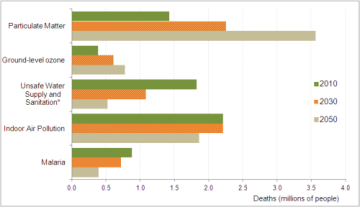That’s the number of deaths that could occur worldwide due to air pollution by 2050 if nothing is done to change the fossil fuel-heavy energy mix, according to a new report by the Organization for Economic Co-operation and Development (OECD). That’s up from 4 million a year today, and it means that air pollution—which includes particulate matter, ground-level ozone and indoor air pollution—would become the biggest environmental health threat, eclipsing the danger from water contamination. The problem is going to be particularly acute in fast-growing developing countries like India, where the air in major cities is already all but unbreathable.
MORE: 10 Most Air-Polluted Cities in the World
It’s also a reminder that air pollution—as long as we depend on fossil fuels–tends to be part and parcel of rapid economic development. Every major country—from Britain in the 19th century to the U.S. in the early 20th century to Japan in the years following WWII—that experienced quick development also had to deal with severe air pollution. The good news is that all of those countries now have much cleaner air, as wealthier citizens pushed for better environmental policies, and the most polluting industries migrated abroad. The challenge is whether that same transition will occur in India and China, where populations are much larger and still much poorer. One certainty: the demand to reduce air pollution ensures that natural gas, which burns much more cleanly than coal, still has a bright global future despite worries over the environmental impacts of fracking.

